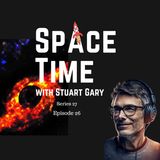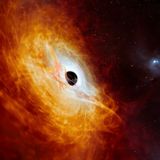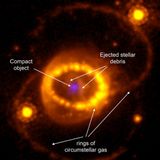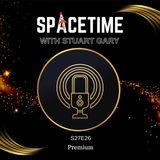S27E26: The Universe's Luminosity Leader: Unveiling Quasar J0529-4351

Scarica e ascolta ovunque
Scarica i tuoi episodi preferiti e goditi l'ascolto, ovunque tu sia! Iscriviti o accedi ora per ascoltare offline.
S27E26: The Universe's Luminosity Leader: Unveiling Quasar J0529-4351
Capitoli
Descrizione
The Space, Astronomy & Science Podcast. SpaceTime Series 27 Episode 26 *The Brightest and Fastest Growing Black Hole Quasar Ever Seen Astronomers have uncovered a cosmic colossus: the most luminous...
mostra di piùSpaceTime Series 27 Episode 26
*The Brightest and Fastest Growing Black Hole Quasar Ever Seen
Astronomers have uncovered a cosmic colossus: the most luminous quasar known, powered by a black hole 17 billion times the mass of the Sun and growing at a staggering rate. The quasar J0529-4351, situated over 12 billion light-years away, is a beacon from the early universe, challenging our understanding of black hole formation and growth.
*Supernova 1987A's Hidden Heart: The Neutron Star Within
NASA's Webb Space Telescope has pierced through the dusty veil of Supernova 1987A, revealing emissions indicative of a neutron star's presence. This discovery resolves a long-standing debate and provides a glimpse into the violent stellar processes that forge these dense remnants.
*Surviving the Cosmic Rays: Earth's First Life and the Shield of Manganese
How did life's early building blocks endure Earth's intense radiation? New research suggests that cell-like structures with manganese-based antioxidants could have been life's ancient protectors, enabling the survival and evolution of the first organisms in a gamma-ray-blasted world.
*Leap Year Explained: Why February Gains an Extra Day
As February 29 approaches, we demystify the leap year phenomenon. Learn how this calendrical correction ensures our timekeeping stays in harmony with Earth's orbit, and discover the historical and astronomical significance behind the extra day in February.
Join us on SpaceTime as we delve into the depths of black holes, witness the aftermath of stellar explosions, and explore the primordial resilience of life on our planet. Tune in for a journey through the cosmos and the intricacies of our celestial calendar.
Listen to SpaceTime on your favorite podcast app with our universal listen link: https://spacetimewithstuartgary.com/listen and access show links via https://linktr.ee/biteszHQ
For more SpaceTime and show links: https://linktr.ee/biteszHQ
For more space and astronomy podcasts visit our HQ at https://bitesz.com
Become a supporter of this podcast: https://www.spreaker.com/podcast/spacetime-with-stuart-gary--2458531/support.
Informazioni
| Autore | bitesz.com |
| Organizzazione | bitesz.com |
| Sito | spacetimewithstuartgary.com |
| Tag |
Copyright 2024 - Spreaker Inc. an iHeartMedia Company






